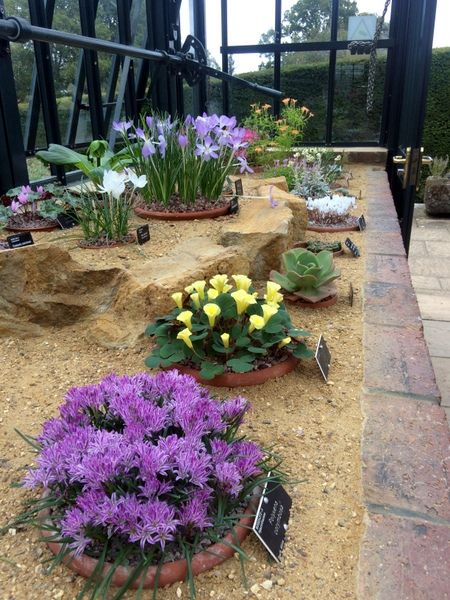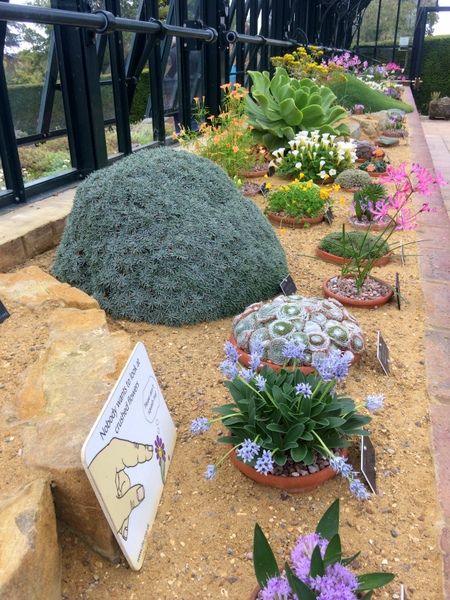I grabbed some stuff to read from the piles stacked on the “sunroom” floor, a small, heavily windowed room with a western exposure just off the kitchen that we use as a reading room. Heading back outside in 100 degree heat, everything got tossed up into the garden lookout over the laundry shed, where I spent a good portion of the Labor Day weekend heatwave. I clambered up the ladder and opened The Rock Garden Quarterly from Fall 2019 to the first article “Sand Plunges at RHS Wisley” by Chloe Wells. Hmmm, something very familiar here…so I climbed back down and ran into the “computer shed” to check the blog, search string “Wisley.”

Thanks to that article, I now fully understand what I was looking at on a trip to England and the RHS Wisley in 2017…sand plunges! Not being familiar with the concept, I thought it was all about display techniques when I visited the Alpine Display House. Not so!
“In winter or dormant periods, we keep our plunges dry. Containers have a perched water table, the volume of soil which will always be moist in the bottom of any pot. The plunge mitigates this effect, acting as a kind of sponge, aiding drainage by providing a continuous movement of water down through the pot so the roots don’t sit wet. The sand also buffers extreme temperatures and keeps roots from freezing.”

“In hot weather, the sand around the pots is kept moist, providing a cool root environment. At times when many alpines are in a slower growth rate (between the natural spring and autumn rains, for exampe), this means we don’t need to water heavily directly into the pot and risk over watering. However, the terracotta’s porosity allows some water movement back into the pots, helping to prevent complete dessication. Roots can use the water in the sand below as an extension of their compost. In a busy department with unpredictabe weather, this type of buffer is essential!“
The “heat dome” over the weekend brought us up to 100 degrees by our home temperature gauges here in Long Beach a mile from the ocean. At 8 p.m. Saturday night the temp was 90, which is incredibly unusual for it to remain that hot near the coast, but by Sunday morning it had dropped to low 70s. Sunday’s temp didn’t seem to fully hit 100 for us and then cooled quickly by nightfall. Much higher temps were of course recorded elsewhere throughout Los Angeles County and varied considerably. Labor Day itself on Monday barely broke into the 80s here. No light penetrates through today’s grey sky, and ash covers the cars from the fires north and south of us. A Pompeiian-like feeling of gloom and doom is unshakeably pervasive today.

On building a sand plunge bench: “Sufficient depth is important, as the deeper the sand, the further away the water table will be from your pot. Line the bottom with polythene or horticultural permeable liner (usually sold as landscape fabric in the U.S.) and drill drainage holes through the wood and liner. Untreated wood will rot fairly quickly, and be sure it is strong enough to hold the weight of wet sand.” Cinder block is also used for building the benches, as photos in the article depict.
I joined the North American Rock Garden Society after the garden bloggers trip to Denver in 2019, where the rock gardens dazzled, and have since found the journal a very good read, highly recommended. (Some rock garden photos from that trip here.)
I seem to have reached that point in the life of a garden and plant obsessive where what I read often touches on something I’ve seen or read in the past, like the sand plunges at Wisley. Or today, reading the blog Prairiebreak by Panayoti Kelaidis, Senior Curator and Director of Outreach at the DBG (who I met and whose garden I visited in 2019), I find he’s explored Greece with a gentleman I’ve just placed a seed order with, Lefteri Dariotis “(better known on social media as ‘Liberto Dario’).” Liberto’s seed list offers an incredible range of sideritis and a silene that coincidentally just germinated in one of my seed trays, Silene fabaria ssp. domokina, “A fantastic Greek native biennial or short-lived perennial with exquisite green and gray leaves with marble like markings during the first year before the upright stems of dropping green flowers form.” I’ve also seen this silene described as a “poor man’s Bukiniczia cabulica.” My seed came from Derry Watkin’s Special Plants. I find that sowing seeds helps get one out of the sticky tar pit of the present and into a lighter, future-leaning frame of mind.
More recent reading of note: In The New Yorker, Jamaica Kincaid’s “The Disturbances of the Garden,” in which she delineates an interesting distinction between the Trees of Life and Knowledge: “I have since come to see that in the garden itself, throughout human association with it, the Edenic plan works in the same way: the Tree of Life is agriculture and the Tree of Knowledge is horticulture. We cultivate food, and when there is a surplus of it, producing wealth, we cultivate the spaces of contemplation, a garden of plants not necessary for physical survival. The awareness of that fact is what gives the garden its special, powerful place in our lives and our imaginations.”
And a documentary very much worth your while, no matter where you garden or what style you subscribe to, is The Gardener, an exquisitely beautiful film of Frank Cabot’s garden Les Quatre Vents in Quebec, which just opened to the public in 2009. Mr. Cabot may be familiar to you for his founding of the Garden Conservancy after visiting the Ruth Bancroft Garden in Walnut Creek, California, and wondering how such gardens can be saved. But you really need to see what he was up to with his own garden, drawing on his travels including wartime experience in Japan and the gardens of Kyoto and plant expeditions in the Himalayas, all filtered through an inquisitive, restless intellect matched by an unerring, gentle taste. There was lots of money in the family for anything he imagined, and thank goodness his imaginings were sublime. The fact that he knew precisely what he was doing in the garden (“I am just a plagiarist”) and what influences he was drawing upon made the interviews with him utterly absorbing for me, even though we are zones, pocketbooks, and worlds apart. Obsessions I totally get in whatever form they arrive.
Lastly, some very sad news: over a million Joshua trees were destroyed in the Dome Fire this August (“Mojave Desert fire in August destroyed the heart of a beloved Joshua tree forest.”) I didn’t think it was possible for my heart to break into even smaller pieces this year until I read “What The Fire Took.”




Is it the rock garden people or the cactus/succulent people who are more perfection obsessed ? I admit to a deep devotion to grooming container succulents-I have so much debris in my garden there is always something I can push out with an artists paintbrush or pluck out with 12″ tweezers. I am always completely and happily focused during this activity. I can imagine hovering over those exquisite rock garden plants in much the same way. I admit I bought some Dianthus after Denver Fling -I used to grow them all the time and was happy to welcome them back-with much more attention to drainage !
I enjoyed following where your reading took you, even into the sad tale of the Joshua trees. Between fires, extreme weather events related to climate change, and the daily news broadcasts, it’s hard not to think we’re teetering on the edge of an apocalypse at times.
Sand plunge…wonder if that would work here to keep Aloe polyphylla alive through a summer.
Also wonder how you got through this past weekend without A/C. It was 108F and 110F Sat/Sun on my patio.
Rescued my mitis albidor from the sun during the last heatwave–it was turning brown. Hotter here, I guess.
Could saw the headline on the Joshua trees–could not bear to read the article. Heart broken too many times lately.
Thank you for the link to The Gardener, I’d heard about it and planned to watch and then lost track. Hope your heat levels are back down to normal. We’re headed for 96 tomorrow and it feels like half of our state is on fire…